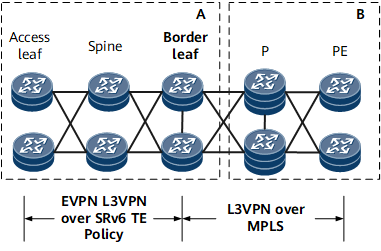Configuring a Border Leaf Node to Provide Interworking Between EVPN L3VPN over SRv6 TE Policy and Common L3VPN over MPLS
During network evolution, an EVPN L3VPN over SRv6 TE Policy and a common L3VPN over MPLS may coexist. To allow these two networks to communicate, configure each border leaf node to provide interworking between EVPN L3VPN over SRv6 TE Policy and common L3VPN over MPLS.
Context
In Figure 1, network A is newly deployed and runs the EVPN L3VPN over SRv6 TE Policy service. Network B is a legacy network and runs the common L3VPN over MPLS service. Alternatively, network A runs the EVPN L3VPNv6 over SRv6 TE Policy service, and network B runs the common L3VPNv6 over MPLS service. To ensure that these two types of networks can communicate with each other and services are running properly, configure each border leaf node to provide interworking between EVPN L3VPN over SRv6 TE Policy and common L3VPN over MPLS.
Pre-configuration Tasks
Before configuring a border leaf node to provide interworking between EVPN L3VPN over SRv6 TE Policy and common L3VPN over MPLS, complete the following tasks:
Configure EVPN L3VPN over SRv6 TE Policy or Configuring EVPN L3VPNv6 over SRv6 TE Policy on the network that contains area A.
Configure a basic BGP/MPLS IPv4 VPN and configure a basic BGP/MPLS IPv6 VPN on network B.
Procedure
- Configure each border leaf node to advertise the re-originated BGP-EVPN address family routes to a specified VPNv4 or VPNv6 peer (PE) or peer group.
- Configure the border leaf node to advertise the routes that are re-originated in the BGP-VPNv4 or BGP-VPNv6 address family to a specified BGP EVPN IPv6 peer (access leaf) or peer group.
- Enable EVPN route advertisement in the BGP-VPN instance address family view.
- Run commit
The configuration is committed.
Verifying the Configuration
Run the display bgp evpn all routing-table command to check information about EVPN routes re-originated after the border leaf node receives VPNv4 or VPNv6 routes encapsulated in MPLS packets from PEs.
Run the display bgp vpnv4 all routing-table command to check information about VPNv4 routes re-originated after the border leaf node receives EVPN IP prefix routes encapsulated in SRv6 packets from access leaf nodes.
Run the display bgp vpnv6 all routing-table command to check information about VPNv6 routes re-originated after the border leaf node receives EVPN IP prefix routes encapsulated in SRv6 packets from access leaf nodes.
